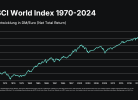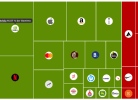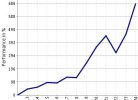By MITCH ZACKS
From an economic and capital market standpoint, 2019 might best be remembered as a year where the trade war dealt some light blows to business investment and overall growth, while dovish monetary policy supported a surge in stock prices. Investors who kept their cool at the turn of last year – when downside volatility ripped through the equity markets – were rewarded for their patience.
So, what’s ahead for 2020? Below, I offer four forecasts I think could play out in the new year.
Volatility and Correction Coming
If you look at the S&P 500 over the last 38 years (1980-2018), you’ll find that not only are corrections frequent, they have been the norm. The average intra-year correction for the S&P 500 since 1980 is -13.9%! In fact, it has been very rare to get a year where the S&P 500 doesn’t fall at least -5% at some point within the twelve-month period. It’s only happened twice in the last 38 years (1995 and 2017), when the S&P 500 declined just -3% intra-year.
In 2019, the biggest drawdown we saw was -7%, making it a below-average year for equity market volatility. In 2020, I think we’re going to see a correction more in-tune with the longer-term average, and I think it would be wise for investors to mentally prepare for it.
History, and the normal and natural nature of stock market corrections, compel my view. But there is also strong evidence that investors are becoming more optimistic and confident, which in my view tends to make the market more vulnerable to selling pressure. The American Association of Individual Investors (AAII) found in its most recent survey that “optimism rose to its highest level in a year, while pessimism fell to an unusually low level.”CNN also publishes a Fear & Greed index showing that ‘greed’ is on the rise. The more that confidence and optimism build, the higher the probability of a correction, in my view.
Further Isolation from China
Markets cheered the most recent truce reached between the U.S. and China, and it feels for now like the world’s two biggest economies have hit the pause button on tit-for-tat tariff levying. But recent history suggests, in my view, that China is likely to fail to follow through on some of its promises, or renege on the agreement altogether.
For example, according to U.S. negotiators, China has committed to agricultural purchases to the tune of at least $40 billion for the next two years, an exorbitant amount by historical standards. In fact, $40 billion of agricultural purchases would amount to almost double the record for what China has purchased from American farmers in previous years. China has growing demand for soybeans and pork, sure, but are they really going to double spending to reach the target? China has done enough overpromising and under-delivering over the years for me to remain skeptical.
Cyclical Surprise
I wrote a Mitch on the Markets column in October 2019 where I pointed out that I’d been “observing a notable rotation away from cyclical sectors and towards defensive sectors.” I also noted in the column that there were nearly “2.5 times the amount of put options on the S&P 500 Index as there [were] call options, and the cost of hedging [had] soared to one-year highs across several equity benchmarks.”
My conclusion: investors were getting too defensive and that opened the door for cyclicals to outperform looking ahead.
Cyclicals have rebounded since, and in 2020 if we have a global economic recovery, we may see corporate earnings growth that spurs this rotation even further. With optimism on the rise and the Fed likely remaining on the sidelines with no plans to tighten, I think cyclical, “growthy” categories will continue to do well and have the possibility to surprise to the upside. However, an investor always has to be somewhat cautious about buying stocks where the earnings growth is anticipated by the market but not yet reflected in earnings estimate revisions.
Income that Isn’t Risk-Free
As mentioned above, the Federal Reserve is likely to remain on the sidelines for much of 2020, in my view, unless there is some unforeseen crisis or negative surprise on growth and employment. On a global level, major central banks appear committed to continued easing, which should keep a ceiling on interest rates and risk-free bond yields. For the millions of retirees out there, and for those planning to retire in 2020, that may mean having to look outside of risk-free Treasuries to generate income in your portfolio.
Fortunately, I believe investors can generate yield in other ways without substantially increasing your portfolio’s risk profile. For example, you could explore the municipal bond market, investment grade corporate bonds, and even dividend stocks as alternatives to create cash flow in your investment portfolio while controlling for risk.
Bottom Line for Investors
Looking back at the last two decades, we find that equities have returned just higher than +10% in years when real GDP and inflation (as measured by CPI) were both in the range of 1.5% to 2.5%. In my view, the U.S. economy should generate real GDP right in the 2% range for 2020, and I believe inflation should at least notch 1.5%. In other words, I believe conditions should be good for solid, perhaps high mid-single digit growth in the new year.
Thank you Mitch Zacks. It’s always a pleasure to follow your thinking and your arguments.
Christian Thiel
Wenn du keinen Beitrag mehr verpassen willst, dann bestell doch einfach den Newsletter! So wirst du jedes Mal informiert, wenn ein neuer Beitrag erscheint!








Das größte und sehr reale Risiko ist ein Ölschock, ausgelöst im Nahen Osten, welcher auf eine schwache und überschuldete Weltwirtschaft trifft. Da könnten die Aktienlichter für einige Zeit ziemlich dunkel werden.
Ich gebe diese Zuschriften nur noch sehr ungern frei. Seit fünf Jahren schreibe ich diesen Blog – und seit fünf Jahren sind die Gefahren für manche die hier kommentieren gigantisch groß. Soll heißen: Du hast Angst. Das ist dein gutes Recht. Warum man aus diesen Ängsten stets und ständig Kommentare machen muss, das leuchtet mir allerdings nicht wirklich ein.
Ein Ölschock ist kein ausgesprochen reales Risiko, sondern zunächst einmal ein eingebildetes, ein ausgedachtes.
So wie es ein eingebildetes Risiko ist, dass in der nächsten Wochen ein großer Meteorit auf die Erde trifft. Beides kann natürlich passieren – so wie viele andere Dinge auch passieren können.
Ein Supervulkan kann ausbrechen. Ja, stimmt. Kann passieren. Und nun?
Nächste Woche können Indien und Pakistan mit Atomwaffen übereinander herfallen. Kann passieren, keine Frage. Und nun?
China kann einen amerikanischen Flugzeugträger im südchinesischen Meer angreifen und versenken. Kann passieren.
Die Amerikaner können eines der Atolle im Südchinesischen Meer angreifen, auf denen China Raketen mittlerer Reichweite stationiert hat. Kann passieren. Ja. Und nun?
Nur weil da draussen alles mögliche passieren kann, werde ich nicht aufhören mein Geld im Markt anzulegen.
Alle diese Ereignisse sind möglich – und zu unserem großen Glück passiert Jahr für Jahr nur ein kleiner Bruchteil der Unglücke, die hätten passieren können.
So ist es schon seit ich die Politik verfolge – und das ist seit der Mitte der 70er Jahre. Was keiner wissen will: Nie war die Welt so ruhig und so friedlich wie heute.
Die Menschen wollen gerne Angst haben. So wie du. Und die Medien liefern ihnen Horrorszenarien.
Und trotz all der Krisen die das 20. Jahrhundert gesehen hat (da waren richtige Weltkrieg dabei und unglaubliche 5 Mio. Tote alleine im Koreakrieg der 50er Jahre) sind die Börsen im Schnitt um 9-10 Prozent gestiegen. Sagen Studien. Das ist der berühmte Sieg der Optimisten, The Triumph of the Optimist, von dem Autorentrio Dimson, Marsh und Staunton – 101 Years of Global Investment Returns: https://www.amazon.de/Triumph-Optimists-Global-Investment-Returns/dp/0691091943